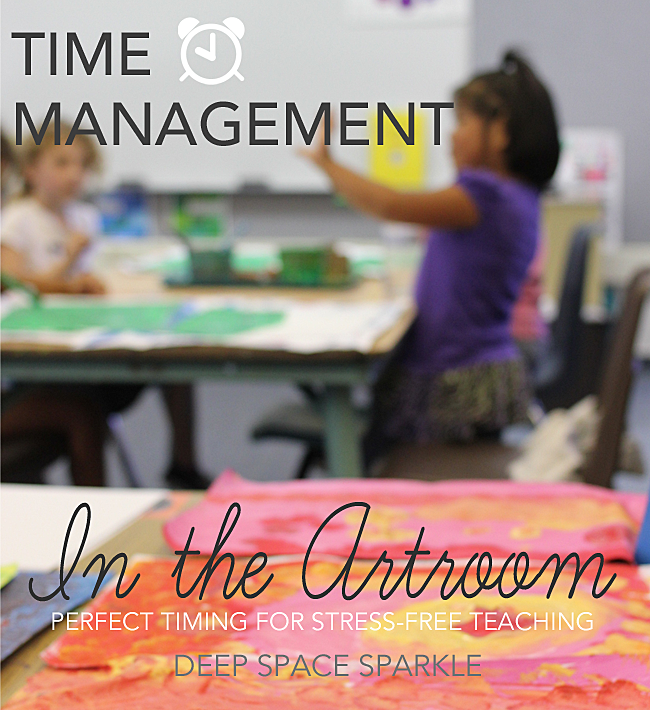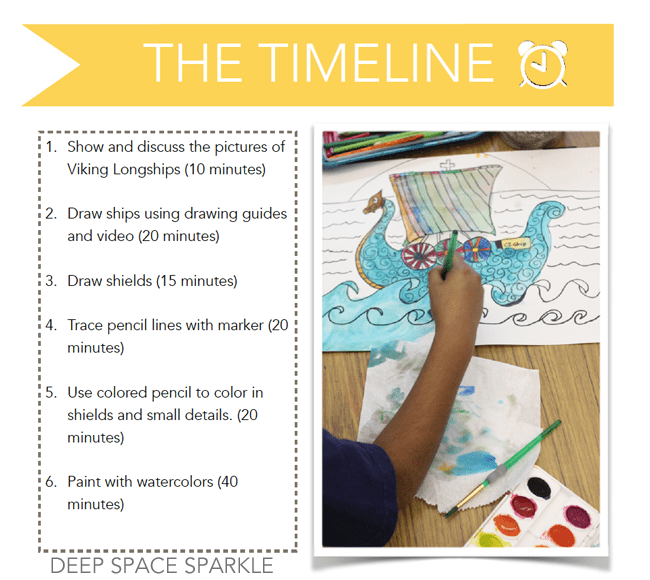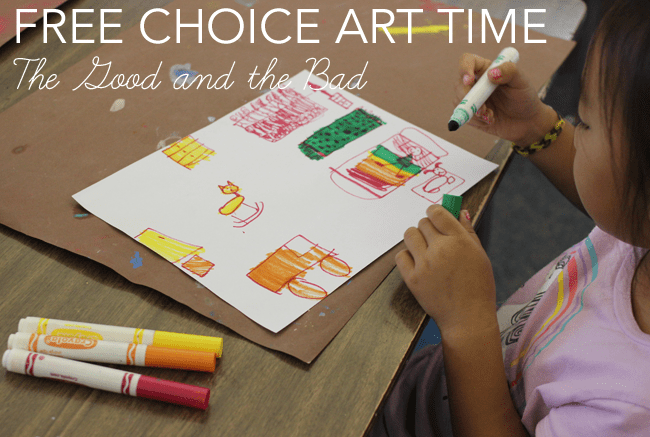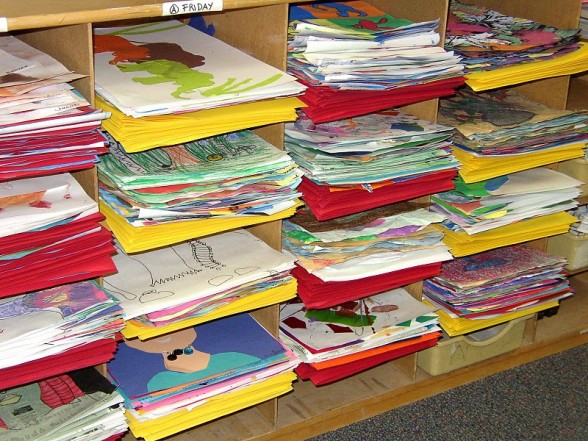
It’s the question everyone wonders about. How do you teach an art lesson so every child finishes at the same time?
Can it be done? Not really, but you can create a classroom so that everyone is working.
Children process information at different rates and children work at different speeds. This is true for adults and so it must be true for children. Intellectually we know this yet we still yearn for art room nirvana. This is the time of year that I experiment with my lesson delivery and timing plus learn to adjust to each class’s needs. It’s also the time when I’m the least effective with managing a timeline. And this is okay. I need to get to know who the kids are, if as a collective group they can work independently without chaos or if they need a bit more structure. I can have multiple classes within each grade level and I will treat the timing differently with each class.
Here are the things I think about and assess:
Are the majority of the kids in the class able to follow multi-step instruction? This may take a lesson or two to determine.
Yes: I do a demo at the beginning of the class that lasts between 7-10 minutes. This usually covers all the steps needed for the first part of a 2-session project or all the steps for a 1-session project.
No: Divide the demo into two sections, one at the beginning of the class and one at the middle. Or if the group really lacks in focus, I slow it way down and just do one slightly longer but easier demo. Going slower is often far less stressful for both the kids and the teacher. Put on some calming music and just let art unfold.
Are there many distractions during class? This can include late arrivals from inclusion student groups, pull-outs, or teacher/aid switches.
Yes: There is not much you can do with a school schedule that is designed to help each child reach his/her potential. For many students art isn’t the most important subject. Don’t take offense to this. There are some very real and hard challenges for kids in school and getting to art class on time might not be on the top of the list. Don’t take this personally, just do the best you can. Welcome the student as if they were exactly on time but don’t start the lesson demo from the beginning. If a child is consistently being pulled out for testing, don’t make it his fault. I used to get a little huffy because I knew I would have to re-teach the lesson over again or I would feel badly because I wouldn’t be able to give this child the extra attention he would need to finish a project. Then one day, I let it go. I allowed the student to re-enter the classroom without commotion. As soon as he sat down at his desk, his table-mates got him caught up with the lesson. Most kids are truly kind and tolerant if you allow them to be.
No: The majority of my classes (⅔) don’t have any major disruptions due to special schedules, so I make sure I remain grateful!
A Typical Art Class Timeline

Before teaching any lesson, I generally have an idea of how long a lesson will take an average student. There will always be students who rush through the steps and some who will take forever. It’s not my place to judge or change a child’s natural behavior but I can offer suggestions. Although it’s probably best to err on the side of caution, you don’t always have to assume that a child is happy finishing in lightening speed. He just may not think he has it in him to do a good job.
If you have the opportunity (which I hope you do!), sit down with the fast worker and talk about ways he can add detail. You may approach this by demonstrating a cool technique that you didn’t show the rest of the class, or bring out a different art supply to add an extra element…basically anything to get the child to slow down and consider what more he could do.
In the above lesson, Viking Longships (available inside The Sparklers Club), some of my students rushed through the painting of the water. I brought out some chalk and showed them how to add value to the waves and shadows long the hull. They loved this and worked a bit harder.
Free-Choice Art Time

I have a station set up in one corner of the art room for free-choice art time. Kids can grab one piece of paper, a few markers and draw whatever they like. At times, some kids can’t wait to get to the “free choice” station and this leaves me wondering if the featured art project was engaging enough.
For the on-task students who use their time effectively, the free choice time is their version of downtime. They can write a letter to their friend, invent the latest quiz for lunchtime entertainment or simply practice drawing something they like.
Kinders usually repeat the very same lesson over and over again. If the art project was learning to draw a pig, they will use their free-choice time to draw a pig.
On the other hand, free-choice time can be a reason to rush through a piece of art. To combat this, I usually ask a child to show me his work and tell me what they like and ask question just to get them thinking about their piece. Often a child will come to the conclusion that his piece isn’t done and will go back to their table to finish. This happens more often than not, so give it a try if you suspect a kid is just rushing through to get to free-choice.
This year, my group of Kinders need a bit more time processing through multi-step projects. Instead of having the children go to the free choice table after they finish step one, I ask them to sit on the carpet and look through one of my art books. I have some pretty cool books in the front of my classroom for this and I have noticed a far calmer transition into the second step of a lesson.
The Benefits of Portfolios
At the beginning of the year, I make an art portfolio for each student. Of course, they can do it themselves. Basically, the portfolio is just a piece of large paper folded in half. I put their name, teacher’s name and grade level on the upper right corner.
After each class, I put the art work in their portfolio. When a student has a few minutes at the end of the class, they can get their portfolio and start any unfinished work. I shouldn’t make it sounds this simple. You have to plan. Early in the school year, I did a series of post about which projects to start the school year off with. (You can find the series here.) I always suggest starting with a line drawing or something a child can continue working on. Line drawings are hard to complete in one class time. And since they only require a black pen, completing a line drawing is the perfect project to work on if there is extra time at the end of a class.
Directed Line Drawings
I love directed line drawings. They have many benefits: develop listening skills, enrich vocabulary, teach shapes and relationships, and on and on. Students love them too. But of course, they can be a bit contrived. But everything in moderation, right?
As far as keeping timing under control, directed line drawings can’t be beat. If you teach the lesson well, meaning provide easy to understand steps and samples, the kids will be enraptured.
This type of lesson keeps everyone on the same page. They’re moving at the same pace…some kids wait a bit for others to catch up, but basically the class stays together. Once the drawings are done, I like to set out paints or other coloring materials on another day.
Making a clean break is lesson steps means that everyone is at the same place the next time you see them. It might help you to teach a few directed line drawings to get the rhythm of the class and to see how much time children need.
Here are a few Directed Line Drawings that work really well:
How to Draw a Pig Koi Fish Painting for Upper Grades
What does your timeline look like? Do you struggle with getting kids to finish at once?
New to teaching art in the classroom? Download my free classroom art teachers toolkit by clicking the yellow box below!













I do the same time with the free-choice art table but I call it the "Got Time? Table"
I hate when they try to rush over there to get 'free drawing paper' as if its a prize…I remind them its there all-year-long and their proejct is more important.
Also, I appreciated your last comment about the two heads instead of one and the glitter–I have to be careful b/c its SO Hard to monitor my reactions and facial experessions and I'm totally working on it! ;0 thanks for the reminder!
I get so frustrated when my children rush to finish a wonderful project to work on free drawing or a colouring sheet. Is it my hang up?
I was actually a bit confused, but intrigued by your comment on "two heads … glitter."
I never know what to say to those kids who PURPOSELY don't follow directions. I don't mean taking an artistic leap, but for example, covering their picture with glue instead of gluing on an object! 🙂 Thoughts?
I have a few kids who, at times, will sabotage their art work. Usually, these kids have underlying conditions that I don't know about. Since I'm not credentialed, the home room teacher attends art class with her students and she usually helps this child.
As for other kids who just don't listen, well, that's another thing and another post!
Patty,
I love your site. I've been following it since last spring and I have used sooo many of your projects in my room. I've been teaching art in a public school system for 6 years now, and it is wonderful to see what others are doing. I started my own blog…although I don't think I will be as prolific a poster as you are ( I have a toddler 🙂 Anyway it is called the lime apron(www.limeapron.blogspot.com). I have NO idea what I am doing, but I have managed to show a couple projects and even referenced you in one. Learning a little at a time. Thanks for all the great ideas and have a happy holiday!
Love, Love, Love, this site. I have been an art teacher for 13 years in NYC. It is the best! Lately I have stopped free time because of all the rushing, and have put out a large book basket., most of the books are art books, which they love but do not rush to finish the project. I sometimes give a prize to the child who finishes last!
Putting out books is something I have considered. I think I’ll give it a go!
I have an area on one side of my room that has a few things that they can choose to do when their work is completed and not rushed through. I have this set up so that they have more options to choose from when they are done and each one is to help improve their art skills, which I definitly notice improvements and confidence growing.
*I have a sheet of paper (that I cut in half so I save paper) and they may do free draw or use a drawing book that I have made copies of and put in folders. The drawing folders has animals, people, cars, etc in it and I’ve noticed that their drawings have been getting much better with the extra practice. Some of them don’t even need the steps any more, they know how to draw it from memory.
* I took paper, cut out organic shapes, and laminated it (so it can be used over and over). They will choose one, trace it onto their free draw paper and figure out what the organic shape looks like, kind of like looking at the clouds. This is a way to expand their imagination and create some GT skills.
* I have a few printed papers that have just a small squiggle line in the center and they finsh the lines by turning it into something and then color it. They may use the back of the paper for free draw or any of the other above examples if they finish it still to early.
* I have play dough in seperate plasic ziplock containers that teaches them to create 3D objects. I show the younger students how to make pinch pots out of the play dough. This improves their building and forming skills that will help when we get to clay.
* I have a large loom that I split into 3 sections so 3 students may weave at a time.
* I also have some books out that they may read and flash cards on multiplication, insects, colors and shapes, capitals, etc.
I wanted to share this with all of you because I was so excited on how this has helped them with their everday art and overall confidence through the extra practice. It also saves paper since allot of them choose to weave and use the play dough.
Emily D. mentioned that she offers her early finishers a basket of books instead of art supplies and so do I.
Offering a basket of books has not only eliminated the urge for students to dash through their art assignment but the books are a great way to integrate silent reading into art time.
Kelly Yerby, East Lansing Schools
I really like the portfolio idea and will be starting my own portfolios this year as well! Time management is crucial for me to keep myself sane and I have a few little perfectionists that need the extra freedom of time that portfolios allow.
Last year I also got permission from my principal to paint 3 of my cabinets – so I chose to make one chalkboard, one dry-erase, and the last one magnetic. With a little tweaking, these cabinets have been a lifesaver when it comes to “what do I do now?” lessons. The kids love the freedom they are given to create art on the cabinets and leave them up for the next class to see.
I’ve noticed that my Kinders will do the project again during their free draw time as well! Too funny!
I manage my early finishers like this: classroom sketchbooks
For one of the first projects of the year, i have the students (gr 1-8) make their own sketchbooks using cereal boxes for covers, folded copy paper and 1 rubber band. They love it and now after 3 years are great at it. I keep all of the sketchbooks for a class in a bag and when they finish early, they get their sketchbook, sit on the carpet and draw, doodle, write, invent or repeat the lesson (!) in the sketchbook.
Having sketchbooks in the room has a number of benefits…no more wasted paper because they only have so many pages in their books (they can add more but it’s more effort!) They learn a cool recycling project they can re-create at home. It’s boring enough not to rush through their projects for but fun enough to keep them busy. No judgements about content so they can make all of the smiling corner suns, hearts and decorated names they want to (no guns or bombs, though!)
Collecting enough cereal boxes takes time but I send out a memo to parents in the beginning of the year and the students bring me “presents” all year long.
Patty do you have any advice on how to manage time with classes that meet for 40 minutes, once a week? I see my K-6 kids at one school one time a week, and I have to walk down to the other end of the school to get some of my classes and have no time in between classes. Plus, I’m only at that school for 4 periods a day and have no planning there ( I leave after 4 classes and head up the mountain to another school). By the time I get the kids to my room and in their seats, get them supplies and set up, 10 minutes or so is GONE and we need to make sure we leave plenty of time at the end for clean up- we have a small sink at the back of the room, but that’s it for clean up space! HELP!
Mrs. Casey Sundahl
Art Teacher
Maysville Elementary (K-6)
Union Educational Complex (K-12)
Hi Casey,
You have a unique schedule but that doesn’t mean it can’t work. Sometimes, it’s best to focus on what you can do in the amount of time you have and not on what time you don’t have. Because logistics cuts into your instructional time, try to focus on materials that don’t require a lot of prep: markers, oil pastels, chalk pastels, water-soluble oil pastels to paint with, etc. Also, see if you can plan your projects so that every class you see uses the same products.
I had only one sink too so I don’t think that’s a problem. If you are struggling with washing hands, use wipes.
You get where I’m going. Your prep doesn’t have to look like anyone else…but you need to make it work so the focus stays on the art. You can do it!
I love the idea of having a portfolio the kids can come back to and finish up previous projects. My question is, how old are the students that you do this with? The kinders and 1st graders are finished so quickly that I have to ask them questions and I have a rule that the entire page must be full. I do this so they won’t rush through the assignment.
Love it!!!!
Hello!
I love your posts! You have inspired many an art project in my art room! Thank you!
I am wondering how students are able to access their portfolios…this is a problem for me as my room has limited space and students getting to their portfolios on their own is always a challenge. Would love some help here as my students often have work unfinished and can only work on their projects on “catch-up” days. Thanks a bunch!
High school is very much like elementary when it comes to time. I have students who will finish a two day project in less than a half-hour, while meticulous students may require half the week. Obviously, my early finishers are problematic. I push the concept of time and assignment value. In my classes, one day is 10 points. A fifty point assignment is a week. When a student turns in underdeveloped work prematurely, I’ll cut him/her off at the pass. I’ll say, “go back and add this.” When they come back, I’ll say, “You’d probably receive a higher score if you added this…” I’ve also resorted to…”Wow, done in half a period–That’s five points. You can take it back to your desk and develop it a little more, or you can generate 25 points worth of extra credit.” I also make it clear, extra credit time does not carry the same value as assignment time.
With high school art, certain freshmen have this tendency to finish a legitimate two day project in a span of ten minutes. Either they are prodigies (nope), or they cannot take there work to the level prescribed. What now? Let’s go back. Often I’ll divide early assignments into phases. Let’s say, for example, we’re working on “Light Value Depiction” on Scratch Art paper. Perhaps the first ten minutes of the drawing would be the “Plotting Phase” during which students use pointillism to “dot-out” important perimeters. How do I know when it’s time to move on? I simply observe. Students who rush can be encouraged to plot more detailed subject content. Next could be the “Outline Phase” in which points are replaced with lines, followed by “Shape Interior Content Phase” and “Value Form Phase.” In breaking the process down, I’m providing students with depiction strategies while managing task time.
Hi! Super useful info for a first year teacher who’s panicking… any additional info is so appreciated!!
the link to the download doesnt go anywhere. I am struggling and could really use all the help i can get. My first year teaching middle school.
Hi Diana! Thanks so much for your interest in the download. You’re right! I alerted tech support and they’ll fix it. Sorry for the trouble! It should be fixed soon.
Thank you, this really helped me learn a lot more about art classes!
Hello Interesting information. I found it helpful. I run after school art classes. I have a huge range of really cool projects for them to master. Most people are fine. I even have adults who join the classes. However I have a few who dont ever want to follow the lessons I set,even though they have choices. Its so annoying. I have one kid who is insisting on doing all of the rainbow friends. He rushes through them. As far as Im concerned I don’t mind some of this style of art but I am getting sick of it. If I’m too strict I lose the student. I need the money. But I get so annoyed at laziness. Should I give in or go with it. I am constantly on the hunt for new students because some people leave. I have other long term students who are fine. I just want good quality . Maybe Im expecting too much.